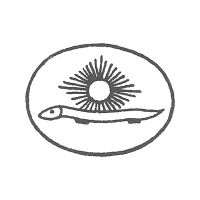
Image 010236-01-01
Used between 1902 and 1909, second mark. Is often shown in reference books like this ...
Lorenz Reichel in 1901 founded a decoration studio in the small town of Schirnding, which at that time had a population of around 600 people. Three years later he already produced his own whiteware and further expanded business so that by 1906 the factory utilized six modern round kilns, had electric lighting and an own link to the local railroad network.
In the year 1909 the business was transformed into a stock company under the leadership of Kommerzienrat Martin Zehendner, who also became major shareholder. One should note that Zehendner together with Christian Seltmann (owner of the famous factory in Weiden) and Johann Wallner also purchased the porcelain factory in the city of Tirschenreuth in 1919. This business relationship helps to explain how the Seltmann family became involved with the factory in Schirnding: Zehendner and Christian Seltmann were not only partners in the city of Tirschenreuth, Zehendner was also a friend of the family and helped Katharina Seltmann run the business in Weiden after the sudden death of her husband Christian in 1921. A few years later, Zehendner decide to retire and so in 1927 he sold his shares of the Schirnding factory to the Seltmann family. Katharina Seltmann saw this as an opportunity to retire as well, leaving the factory in Schirnding to her son Heinrich Seltmann (*1899, †1979) while her son Wilhelm Seltmann took over the factory in Weiden.
Following WW2, Heinrich Seltmann greatly invested in factory modernization and his knowledge and intuition helped to quickly (re)establish many business relationships which secured a constant number of profitable orders. During the 1960's his son Dieter Seltmann (*1938) joined the board and with his ideas managed to influence the product range by including a few modern designs. After the death of Heinrich Seltmann in 1979, Dieter Seltmann took his place as main director of the factory.
After the reunification of Germany in 1989/1990, the already reclining German porcelain industry encountered more and more problems (next to the negative influence of cheaper Asian products) as the former East German factories, having lost their former restrictions, flooded the market. The Schirnding factory therefore was forced to look for new partners and business relationships and so (from 1991 onwards) cooperated with the British Royal Stafford China Ltd. from Stoke-on-Trent when it came to producing Bone China ware.
That however was not enough to secure business and in November 1993 the three medium-sized porcelain manufacturers Schirnding AG (Schirnding), J. Kronester (Schwarzenbach an der Saale) and Johann Seltmann (Vohenstrauß) therefore merged into the SKV-Porzellan-Union GmbH group. Only a year later, the group purchased the trademark rights of the bankrupt Bareuther company from the town of Waldsassen. All Christmas Plates and other collector series formerly created by Bareuther were from 1994 onwards produced by the factory in Schirnding which continued to issue the series under the Bareuther brand, which of course made many people believe that the corresponding factory still existed.
For the Seltmann factory in Vohenstrauß, the mentioned merger was only a short relief as the group on October 27th 1995 declared the closure of the facility due to economic reasons. The remaining part of the SKV was able to continue, finally being joined by the well-known Porzellanfabrik Arzberg factory which previously belonged to the Hutschenreuther AG (Selb) and had been sold off to the Winterling AG (Kirchenlamitz) in 1997. The whole Winterling group however had drifted into financial problems and eventually announced insolvency in 1999, so the SKV-Porzellan-Union GmbH made an offer to take over the Arzberg trademark and assets which was accepted in August 2000.
The name change to SKV-Arzberg-Porzellan GmbH was followed by the move of the main office from Schirnding to the city of Arzberg. During this period, the company was more and more influenced by Mr. Helmut Sättler (former manager in Arzberg since 1997) and the internationally renown designer Peter Schmidt. Together, they successfully repositioned the group on the market and the traditional Arzberg design trademark became its main asset.
After Arzberg had become the primary brand of the company, it was then decided to adapt a new name in June 2004. The SKV-Arzberg-Porzellan GmbH became the Arzberg-Porzellan GmbH and in the year 2007 employed a total of around 250 people (a number which, due to optimized production, dropped back to 230 by 2009). In this context one should hold in mind that Schirnding eventually became an Arzberg sub-brand, hence one may bump into marks stating Schirnding by Arzberg.
I will later link from here to the corresponding Arzberg page when that entry is completed as the former Schirnding factory became a production subsidiary of the Arzberg factory, hence their history started here but will (probably) end in Arzberg.
As mentioned above, the Christmas plates and similar editions originally produced by Bareuther where from 1994 onwards produced by the factory in Schirnding. Next to the three name changes during that period, the most confusing part concerns the marks re-used in that process: the 2009 Christmas plate for example actually had the Bareuther "125 years anniversary" mark from 1991 on the box.

Image 010236-01-01
Used between 1902 and 1909, second mark. Is often shown in reference books like this ...
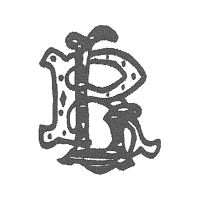
Image 010236-01-02
... however the original registered by Lorenz Reichel looks like this.
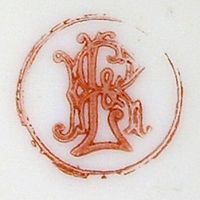
Image 010236-01-03
Used between 1902 and 1909. Third mark registered by Lorenz Reichel. Intended for export but barely used.
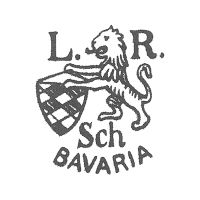
Image 010236-01-04
Claimed to have been used between 1905 and 1909 on export items intended for the US market.
(Picture: Loredana Ruvolo)
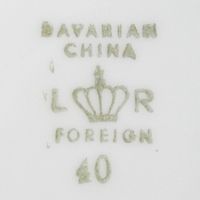
Image 010236-02-01
Introduced 1909 and only used for a short time.
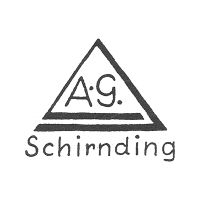
Image 010236-02-02
Used between 1909 and 1925, crowned shield containing the initials "PS" divided by a band stating "Schirnding".
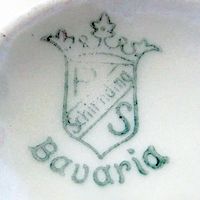
Image 010236-02-03
Used between 1909 and 1925, same as before. Often accompanied by a stamped internal code.
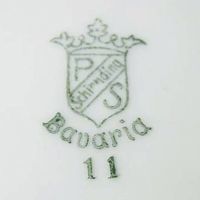
Image 010236-02-04
Used between 1909 and 1925, same as before. Here an example with additional handwritten production codes.
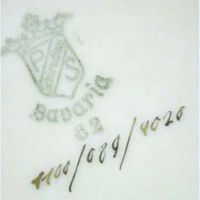
Image 010236-02-05
Used between 1918 and 1925. Fancy shield including "PS" and "Bavaria".
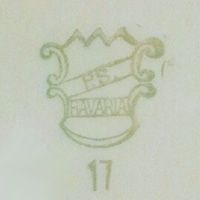
Image 010236-02-06
Used between 1925 and 1936, crowned shield containing "PS" and "AG" divided by a band stating "Schirnding".
(Picture: Trudy Schrader)
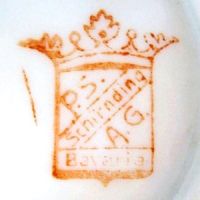
Image 010236-02-07
Used between 1934 and 1945, registered at the RWZR under №·475·992 on May 23rd 1935. Ostmark was a regional descriptor.
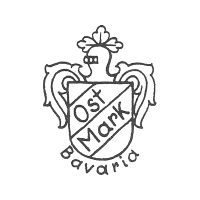
Image 010236-02-08
Used around 1940. A trademark stamp using the Offenbacher Schrift writing style; it shows "Kosag feuerfest".
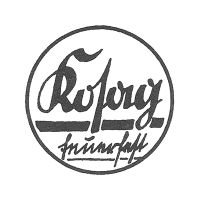
Image 010236-02-09
Used between 1946 and 1948, post-war mark with included "US Zone" addition.
(Picture: Esko Ikäläinen)
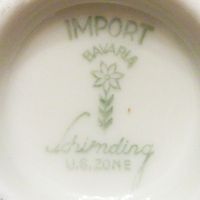
Image 010236-02-10
Another example. The "Import" addition was most commonly used on exports to Poland.
(Picture: Ulf Jansson)
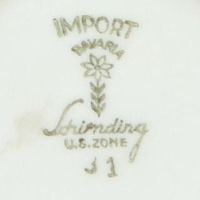
Image 010236-02-11
Used in 1949 only: additionally stamped "Made In Germany US-Zone".
(Picture: Esko Ikäläinen)
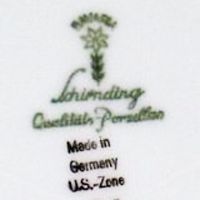
Image 010236-02-12
Used between 1949 and 1956. Here "Qualitäts-Porzellan" only, often with "Made in Western Germany".
(Picture: Stephanie Urwich)
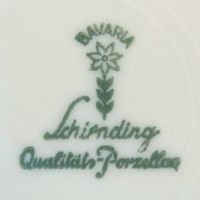
Image 010236-02-13
Used between 1956 and 1974. "Bavaria", stylized Edelweiss above "Schirnding", here with the series name "Hannelore".
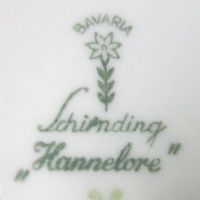
Image 010236-02-14
Used between 1956 and 1974. "Bavaria", stylized Edelweiss above "Schirnding", here without any additions.
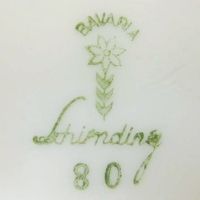
Image 010236-02-15
Used between 1956 and 1974. The "Feston" series had a special mark, this also reads "Deutsches Qualitäts Porzellan".
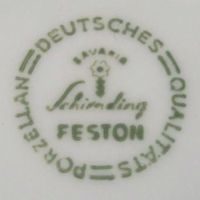
Image 010236-02-16
Used between 1964(?) and 1974. Nearly the same as before; note that the flower petals are smaller on newer marks.
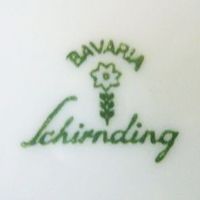
Image 010236-02-17
Used between 1974 and 1989. Note the "Made in W.Germany".
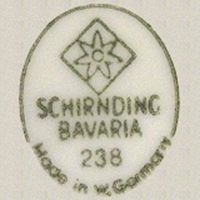
Image 010236-02/03-01
Used between 1977 and 1995, on various (collector) series not really intended for export.
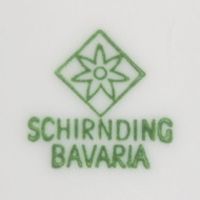
Image 010236-02/03-02
Used between 1977 and 1995, here on an item (re)decorated by the business in Plankenhammer / Floss.
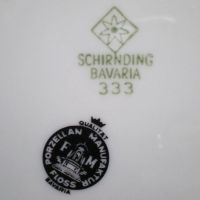
Image 010236-02/03-03
Used between 1989 and 1991. These marks show a gap before the word "Germany" as the "W." was simply removed after German reunification.
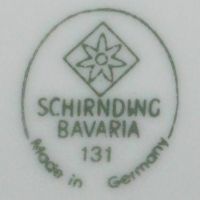
Image 010236-02/03-04
Used between 1992 and 1995. This mark is the second post-reunification version with corrected text flow.
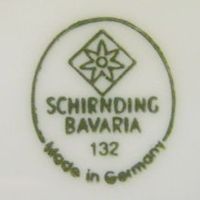
Image 010236-03-01
Used from 1995 onwards, simle "Schirnding" above "Made in Germany".
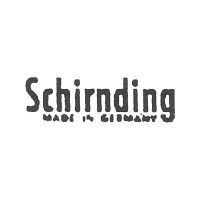
Image 010236-03-02
An example of double branding on a "Schirnding" special edition for coffee machine producer Saeco.
© 2004-2025 C.S.Marshall, all rights reserved